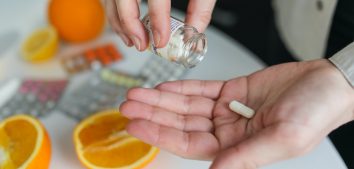
Oh, the hormones…
Swelling, retention of water in the body, excessive irritability, fatigue … Do you know these problems? You are not alone! Just like many other women, I also experience them. These ailments are associated with physiological fluctuation of the hormone levels that occurs during the menstrual cycle. In today’s post I will show you how the level of hormones can affect our appearance and well-being.
The course of the menstrual cycle
The menstrual cycle begins with the first day of menstrual bleeding and ends on the last day before the onset of menstruation. This cycle includes two phases: preovulatory, dominated by estrogen and postovulatory activity, in which progesterone plays a major role. Both phases are separated by the moment of ovulation, which occurs about 14 days before the onset of menstruation.
The purpose of the preovulatory phase is to restore the exfoliated uterine mucosa. This phase is also aimed at preparing the woman’s body for the next menstrual cycle. During this period, ovarian follicles grow, develop and mature as a result of estrogen activity. One of the them develops as a Graafian follicle, and when it reaches maturity it breaks and releases the egg cell.
In the postovulatory phase, there is an increase in the secretion of progesterone produced by the corpus luteum formed by a ruptured Graafian follicle. If no fertilization occurs, the corpus luteum dies, which is related to the simultaneous decrease in the level of progesterone, ischemia of the mucous membrane and its exfoliation, which results in the occurrence of menstrual bleeding.
The standard duration of the menstrual cycle is 28 days, but cycles lasting up to 35 days are also considered normal. The duration of the preovulatory phase in individual women may vary, while the duration of the postovulatory phase in most women is fairly regular and amounts to about 14 days.
Hormones and well-being
The changes in hormone levels (mainly estrogen and progesterone) occurring in the female body during the menstrual cycle may lead to changes in appearance, physical condition, emotions, and intellectual performance. During the rise in estrogen levels, most of us do not observe any disturbing ailments. On the contrary, many of us experience an increase in libido and we look better. However, disturbing ailments usually appear in the second phase of the menstrual cycle. Problems reported during this period include fatigue, drowsiness, poor emotional condition, increased nervousness, decreased concentration, deterioration of intellectual performance, decreased libido and skin deterioration. Most women experience at least one of these ailments in this period, which is considered a physiological phenomenon, as long as it does not hinder normal functioning.
Premenstrual syndrome
In some cases, the severity of complaints associated with postovulatory period may be so great that it may significantly affect our quality of life. In this case, we usually deal with premenstrual syndrome, which is defined as a set of emotional, somatic and behavioral symptoms that appear in the period from 5 days before menstruation and give way up to the 4th day of menses. Women who are overweight or obese, experience high levels of stress, or are addicted to psychoactive substances, are especially vulnerable to premenstrual syndrome. The occurrence of menstrual tension syndrome may also result from genetic predispositions.
Symptoms
The diagnosis of premenstrual syndrome requires a minimum of two months observation of symptoms and an assessment of their impact on the daily functioning and quality of life.
The most frequently reported complaints associated with premenstrual syndrome include:
- flatulence
- digestive disorders
- constipation
- swelling
- breast tenderness and pain
- headaches
- increase in appetite
- fatigue
- skin problems
- drop in mood
- irritability and nervousness
- difficulties with concentration
- insomnia or excessive drowsiness
The most annoying ones are irritability and anger, which intensify about two days before the planned menstruation.
Can the occurrence of these symptoms be prevented?
Of course it can! Studies carried out so far have shown that lifestyle modification including following a proper diet and physical activity can significantly improve well-being and quality of life of women with premenstrual syndrome.
Physical activity
The impact of physical activity, especially aerobic exercise, on the general well-being of women has been confirmed in many studies. Aerobic exercise was also effective in reducing the severity of premenstrual syndrome symptoms. Moreover, the beneficial influence of yoga on the reduction of ailments occurring in the second phase of the cycle has been demonstrated. The observed improvement in well-being, however, depended largely from the duration and frequency of exercise. According to the American College of Obstetricians and Gynecologists, physical activity should be performed for at least 30 minutes a day and repeated at least several times a week if we want it to be effective.
Diet
The modification of eating habits is one of the most effective ways to prevent the symptoms associated with premenstrual syndrome. The most frequent recommendations concern limiting the consumption of salt and salty foods. In addition, you should avoid consuming products with high caffeine content, which may lead to exacerbation of emotional symptoms. It is also reasonable to cut down on sweets and to choose wholegrain cereal products. Alcohol should also be avoided. Adequate weight loss can also play an important role. Supplementing vitamin D is worth considering too, especially in autumn and winter. In the alleviation of PSM ailments it may also be helpful to use some herbal preparations, such as Japanese ginkgo or St. John’s wort.
As you can see, premenstrual syndrome is not a myth but a real problem for many of us. The accompanying symptoms can significantly disturb the daily functioning of a woman. However, following a proper diet and increasing the level of physical activity can significantly improve our well-being and quality of life.
Bibliography:
- Pałucka Klaudia, Łepecka-Klusek Celina, Pilewska-Kozak Anna B., Pawłowska-Muc Agnieszka K., Stadnicka Grażyna. Zespół napięcia przedmiesiączkowego – mit czy rzeczywistość = Premenstrual syndrome – myth or reality. Journal of Education, Health and Sport. 2016;6(6):478-490.
- Ryu A, Kim TH. Premenstrual syndrome: A mini review. Maturitas. 2015;82(4):436-40.
- Silberstein SD, Merriam GR. Physiology of the menstrual cycle. Cephalalgia. 2000;20(3):148-54.
- Thiyagarajan DK, Jeanmonod R. Physiology, Menstrual Cycle. 2018 Oct 27. StatPearls [Internet]. Treasure Island (FL): StatPearls Publishing; 2019 Jan. Available from http://www.ncbi.nlm.nih.gov/books/NBK500020/











Comments No Comments
Join the discussion…